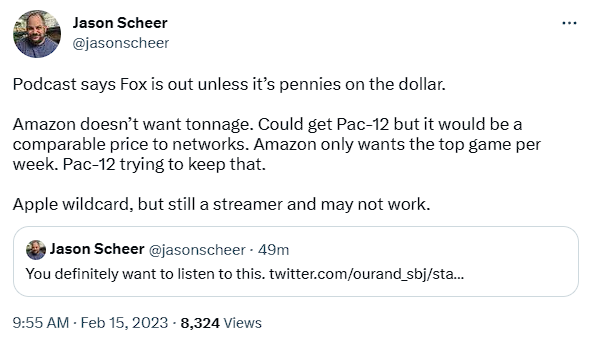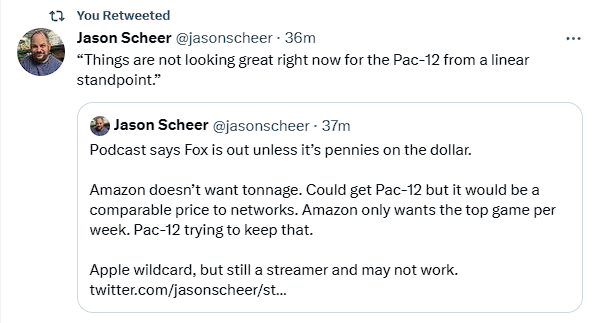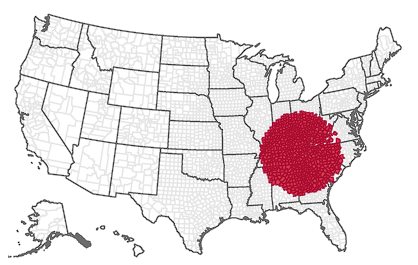Football ...
Basketball ...
Baseball ...
Other Sports ...
Futbol ...
🤫995🤫 ...
Gambling ...
Movies & TV ...
Music ...
Hobbies ...
Lulz ...
Food & Travel
...
Daily Texan ...
Business & Markets ...
Cloak Room ...
Help ...
For Sale ...
Board Discussion ...
Advertise...
Tailgate Donations
-
Posts
2294 -
Joined
-
Last visited
Content Type
Profiles
Forums
Store
Downloads
Recruiting - 2020
2019-2020 Football Season
Football
Entertainment
Sports
News and Business
Cloak Room
Transfer Portal
Recruiting
Events
Everything posted by Hurtlocker
-
He has 12k followers....he only follows 721. He's the publisher for Wildcat Authority, the Arizona 24/7 fan site.
-
Realignment chatter: How the Pac-12 holds the key to it all Summary: Why would Amazon do a Pac deal, when it can carve out deals with the Big Ten/Big 12 with less schools if they move. Likely no movement until the Big Ten has a new commish ACC has a divide between schools who don't need money and those who need more to keep up Stanford/Cal seem to be unwanted with Stanford only having a chance as an ND rival add The real mess will be in six years when the Big Ten/Big 12 reup their deals and the ACC is still on the old one.
-
They feel they have more in common with Penn, and Harvard, and Princeton.
-
NCState and VTech are FAR more likely though. Tech is just down the road from Tennessee, even playing the Vols at Bristol Motor Speedway right between the two campuses. Far more SEC like atmosphere than UVA, which is more like attending the Kentucky Derby, or the Masters, or a Taylor Swift concert. If UVA stayed in the ACC it may be very unlikely Tech would bolt though, considering the state flexed on UVA to force the ACC to take Tech when the Big East melted.
-
Only idea I heard that made sense for the Big Ten was to get ESPN as a partner again on the 10:30 est slot, e.g after dark, and if you got UW/Oregon, you could play one of those two on the west coast weekly. Doesn't really fit every week, but if you could get $150m for that it helps pay their way.
-
Will the Pac-12 break up? Where each team would go if league disintegrates over media rights deal A college landscape without the Pac-12 has become a storyline worth considering, though a break-up of the 107-year-old league isn't particularly likely. Industry sources still project a media rights deal split between ESPN and Amazon for the embattled conference. However, dissolution of the Pac-12 is being talked about openly in those same industry circles as a potential consequence if the league does not wrap up its new deal soon. The fact that it could happen in these tenuous times is enough to project what the process might look like. Multiple sources tell CBS Sports the league is struggling to match its desired value for its 10-team league (south of $400 million annually, $40 million per school) following the departures of USC and UCLA to the Big Ten. The most compelling reason: As it stands, the Pac-12 inventory of games is not something broadcast, linear cable or streaming must have at this point. Not without USC and UCLA. Not with the league is in its eighth month since losing its two flagships. And not with 3.5 months having passed after the Pac-12 was leapfrogged by the Big 12. The Big Ten is now coast-to-coast, spread across the three major broadcast networks (CBS, Fox, NBC). ESPN has gone all in on the SEC with an exclusive deal including the lucrative 3:30 p.m. ET window on Saturdays as well as the primetime slot with some of the highest-rated inventory in the sport. The ACC is locked in through 2036 at a stable number that is expected to grow as the ACC Network continues to throw off revenue. The Big 12 has staked its claim with Fox and ESPN, and it is looking to get bigger with expansion. There is a finite amount any potential rightsholder is willing to pay for a damaged conference that is the last among the Power Five to complete a new media rights deal. Perhaps that was the implicit intent of the conference's recent statement from its presidents -- to calm fears. Now consider what has impacted the Pac-12 and some of its potential bidders just since the beginning of the year: The league discovered it may owe a media partner $50 million. Disney (parent company of ESPN) announced it is laying off 7,000 employees in a restructuring. Amazon recently laid off 6% of its work force (18,000 globally). Alphabet (parent company of Google) cut 12,000 jobs. The Pac-12 may have simply waited to too long to do a deal that makes financial sense to some of its members. CBS Sports previously reported the Pac-12 may have to commit to expansion in order to maximize the value of a deal. The bulk of the other Power Five's games are on what are still-reliable linear platforms (broadcast, cable). Linear continues to outperform streaming by a large margin. Consider, during the 2022 season, the SEC and Big Ten had a combined 50 conference games that finished in the top seven of the weekly TV ratings. The Pac-12 had one such game that didn't include USC or UCLA, according to SportsMediaWatch.com When the Big 12 similarly lost its two flagships programs, the league acted decisively to expand under then-commissioner Bob Bowlsby. Under new commissioner Brett Yormark, the Big 12 jumped ahead of the Pac-12 with that new media rights deal. The Pac-12 has reached a point where the best broadcast windows on the best networks are filled with premium content from other conferences while streaming remains an unproven home. Did the league simply overvalue itself? Taking all that into account, here is a step-by-step look at what would happen if the Pac-12 disbanded. Why would the Pac-12 break up? Basically, the current members would get nervous enough over a lack of value coming back to them in a media rights deal in conjunction with dissipating exposure and perceived prominence for their universities and athletic programs. How will Pac-12 games be seen by a broad audience if they are not on TV or the best windows, which are filling up fast. If significantly more than half of future Pac-12 games project to be on a streaming serve, as CBS Sports previously reported, that's a bad sign. Again, linear is still the preferred delivery system for live sports. On a streaming carrier, the Pac-12 would lose significant visibility That translates -- for starters -- to declined recruiting and a struggle to hire top coaches if their games will not be widely available. If individual or collective Pac-12 schools sense they can make more money and receive better exposure in another Power Five conference, they have no choice but to look out for the long-term financial security of their universities and athletic departments. Football (and basketball) media rights basically fund a program's remaining sports. Where would Pac-12 teams go? If the Pac-12 ultimately breaks up, most -- but not all -- of its membership would find waiting Power Five homes. It would kick off another round of expansion and may result in further changes coming down the road. Four Corners schools Arizona, Arizona State, Colorado and Utah have been Big 12 targets, in some form, since USC and UCLA announced plans last summer to leave fo the Big Ten. That interest has picked up considerably with the Pac-12 appearing even more vulnerable. Yormark wants to have membership in the Pacific Time Zone. That would make the Big 12 the only conference to have members across all four time zones. Adding the Four Corners schools would also make the Big 12 the third conference with 16 members joining the SEC and Big Ten. Arizona would enhance the Big 12's basketball reputation. (Gonzaga is in consideration as a basketball-only member.) Arizona State is one of the biggest sleeping giants in the country playing in the nation's 11th biggest market (just outside Phoenix). Colorado is a former Big 12 member, achieving its greatest success in the league in the old Big Eight. Deion Sanders at CU is a walking, talking marketing executive. Whatever he accomplishes, it can't hurt viewership. Utah (along with Oregon) is arguably the Pac-12's strongest remaining football program. It would also give BYU a travel partner. In essence, adding those four schools would create more Big 12 content in more time slots. Such an expansion might reflect what the Pac-12 is worth right now. If the Big 12 expands, its contract states new team(s) would get 63% of pro rata revenue from ESPN (approximately $20 million annually). If that's what compels those schools to move, what does it say about the current worth of the Pac-12? Oregon and Washington Assuming the Four Corners bolt first, that creates a decision for what would become the two biggest available brands in the country. Keyword "available" because, with the league crumbling around it, Oregon and Washington would have options. And their best option would likely be the Big Ten. The schools align academically with the Big Ten. They would join USC and UCLA, mitigating travel issues in the Big Ten for all four schools with more games closer to home. Even if the Pac-12 stays together, how long until Oregon and Washington have wandering eyes? Nike founder and Oregon benefactor Phil Knight has been looking out for the Ducks since early in the process. CBS Sports confirmed Washington's interest in the Big Ten last fall, which was termed significant at the time, if the Pac-12 didn't work out. It is known outgoing Big Ten commissioner Kevin Warren wanted further conference expansion seeking to add those two schools as well as Stanford and California. There was much pushback from Big Ten presidents and athletic directors, but with the Pac-12 potentially decided its own fate, the Big Ten wouldn't be perceived as breaking up the league this time around, avoiding a possible costly legal challenge. (This time, however, the Big Ten would likely want no part of Stanford and Cal.) An 18-team league would make the Big Ten the biggest in the history of major-college football. It would create significant scheduling issues and result in balking from existing rightsholders, who will be asked to pay more. Perhaps a streaming service would get involved to defer costs. Best guess: Oregon and Washington would take less than a full Big Ten share (estimated $75 million per school starting in 2024) at least initially to be part of the richest conference in the land. The last four Out of that upheaval emerges a conference of leftovers. Think of a Pac-12 -- or whatever it is called by then -- attempting to forge ahead with its four remaining schools (Cal, Oregon State, Stanford, Washington State) while filling the rest of the conference with Mountain West programs. (It could also go the other direction.) San Diego State and SMU are already projected as expansion candidates if the Pac-12 survives, so pencil them in to make it six teams in the hybrid league. A corner bar discussion might reveal a new Pac-12 that looks like this: Cal Boise State Fresno State Oregon State San Diego State SMU Stanford Washington State That lineup would reduce the Power Five to the Power Four, creating implications beyond the Pac-12 itself. Pac-12's best chance The way out of this muck is a 12-team league that includes San Diego State and SMU appearing to present more value to potential rightsholders. The Pac-12 has been positioning itself for such an expansion while struggling to meet its goals. SDSU gives the Pac-12 a presence once again in Southern California. SMU gives the league some things it never possessed: games in the noon ET window and a recruiting foothold in Texas. We've detailed San Diego State's advantages. Adding the two teams would give rightsholders 90 Pac-12 games on which to bid. But again, that's assuming there's enough bidders with enough money left for the remains of the Conference of Champions.
-
Yeah they won't split, they're the east coast, public grandaddies. Outside the UNC/Duke game in basketball, they care more about each other than any other school in their state. Neither need any money, get all the exposure they care about, and control their own show. While I can see Clemson and FSU chomping at the bit, if UNC/UVA were given the choice between "twice as much money" or they "get to do their own thing", I'd bet my house they'd pick "Do their own thing". Its a vibe that is hard to describe, but is probably more like Stanford or other Pac schools who don't view athletics as their tip of their institutional spear.
-
Not a huge impact on realignment, but women's sports have been surging recently, including basketball, soccer and softball. LSU/SC wbb just had an average audience of 1.5m and the women's softball tourney last year was out drawing baseball games.
-
Front Office Sports' Latest: As Networks Pull Out, Amazon ‘Playing Hardball’ With Pac-12 The silk gloves have come off in media rights negotiations between Amazon and the Pac-12 Conference. And here comes the steel fist that’s helped make Amazon the country’s dominant e-commerce company. Amazon is “playing hardball” in media rights negotiations with the hapless college conference, sources told Front Office Sports. The tech giant is holding out for the best game matchups and best financial terms, sources said. Founder Jeff Bezos’ Amazon didn’t grow to $513 billion in annual revenue by playing nice. If the Pac-12 thinks it’s going to get rich from Amazon, they’re mistaken, sources said. And the more bidders who drop out of negotiations, the more leverage Amazon has over the conference. Both CBS Sports and Warner Bros. Discovery Sports are out of bidding, according to Brett McMurphy of Action Network. All this comes, of course, just days after the conference issued a statement saying they expected to ink a new media rights package “in the near future” — and characterized the negotiations as “positive.” That leaves Amazon, Fox Sports, NBC, and ESPN among a dwindling list of suitors for the Conference of Champions. The problem for the Pac-12 is most of the big media entities have inked football deals in recent years. Or they’re hoarding cash as the U.S. advertising market weakens and an economic recession looms. In August, the Big Ten finalized a seven-year rights deal with Fox, NBC, and CBS worth a record $7 billion. So put down Fox as a longshot. NBC is all-in with the Big Ten and Notre Dame. The Peacock network’s new Big Ten deal runs through the 2029-2030 season. Its longtime deal for Fighting Irish home games runs through the 2025 season. So they can probably be counted out, too. Amazon already has its big pro football deal in place with the NFL, paying $1 billion a year to exclusively stream “Thursday Night Football” through 2033. Do they need the Pac-12? Probably only on their own terms. Then there’s Walt Disney Co. The majority owner of ESPN has outbid competitors over the decades for college football rights. But Disney has suddenly discovered the virtues of frugality. During a conference call with analysts, returning chief executive officer Bob Iger warned the entertainment giant will be more “selective” about expensive sports rights. “I’ve had long conversations about this with (ESPN president) Jimmy Pitaro. And we’ve got some decisions that we have to make coming up — not anything particularly large, but on a few things, and we’re simply going to have to get more selective,” Iger said. After all, ESPN already re-upped with the Big 12. And the network has expressed interest in retaining NCAA championship media rights, sources previously told FOS. The NCAA Division I women’s basketball tournament alone will likely be worth more than twice the $34 million a year that ESPN is currently paying. The Pac-12’s current 12-year deals with Fox and ESPN run until 2024 and carry an average annual value of $250 million. But USC and UCLA are bolting for the rival Big Ten in 2024. The loss of those two prominent schools, and most of the Los Angeles TV market, is weighing heavily on Commissioner George Kliavkoff’s negotiating options. Both the Pac-12 and Amazon declined to comment.
-
Yeah none, and the two everyone wants, UVA/UNC, are the core of the ACC and its biggest power brokers. The rest of the conference kind of orbits around that relationship and, if you think the Pac looks down on the Big 12, UVA/UNC feel that way about all the other conferences, except maybe the Ivy. I can't see how they'd be pried away unless the rest of the conference fractures. But, outside them, all anyone else is going to want is FSU or Clemson, so it won't fracture enough. And, while money is more, I am pretty sure both AD's run off massive trusts. They're also both basketball heavy schools. UVA students earn points for each sporting event they attend, but not to get them better seats at football games - points they get going to football games (or women's soccer or LAX, or whatever) gets them priority seats at men's basketball games. I see the ACC thing being a Clemson/FSU issue, not an ACC issue.
-
bwahahaha...
-
Probably not saying anything new, but from the guy who covers Arizona recounting a Sports Business Journal Podcast
-
This. Those projections circling around $75-100m are based on 9 conference games, which is what the Big Ten does. OOC match ups provide little to no value to a contract.
-
Yes it is basically forfeiting a percent of revenue for this and next summer. The only check I've heard being sent is $20m to Fox, along with the scheduling change to get both Michigan/Texas games in lue of the 2024 River. It all makes sense, the buyout was always going to be the buyout, now the remaining 8 are even for the cut they were taking to let in the new four. Its all basically a wash, aligning everything with the CFB Playoff going to 12. As someone mentioned earlier, $25m isn't exactly a rounding error, but its basically the profit the AD ran last year. Not devastating. This looks like it was purely Fox wanting its eight games in 2024.
-
Exactly this, its going to be an interesting development how this media deal shakes out. The Pac 12 played for money over exposure and may miss out on both. There just aren't any more windows open except late night, which is mostly watched by the west coast anyway. So you get paid and no one sees you, that's a short term win. There is a reason the SEC let CBS market their 3:30 game for basically free for a decade longer than they needed. The order is exposure first, cash in second. The Big 12, while on the ropes, carved themselves out an exposure contract and, while not big brands, actually play ball. It was reported around the time the Big 12 signed their deal that the viewership of non-Texas/OU games has increased by about 40% over the past few years (still well below Texas/OU games, but growing at a sizable rate) and their deal is up in 2031. IF they keep increasing viewership and IF the Pac fades even more away, their next contract could be from a poaching position. I wouldn't be surprised if we start seeing more leaks soon, like when FSU/Clemson wanted their own network, as Pac12 brass try and get a GoR for a decade and Oregon/UW/Zona all want a 4-5 year deal as a wait it out move.
-
I get the point, I don't agree with it. Tennessee has more recruits in the window you mentioned, more competition, but more recruits. Oklahoma has less competition, but less recruits. In order to reach more recruits, they get more competition. And they don't own DFW, pretty sure you'll have heavy competition, as always, in that market. Again, this isn't an "Oklahoma won't have top recruiting classes" point, its being on an island doesn't provide an advantage. Unless they were like in the middle of Texas, with no other Texas schools. THEN maybe it would. Oh, and Ames has 27m people within 300 miles and 50m within 450. They're on a bigger island than Oklahoma. They just don't have the brand to do anything with it and, its not south of that line we talked about.
-
I wasn't saying Oklahoma won't be able to recruit. I don't really imagine that's going to change much. Top ten now, top ten later. Winning drives that ranking more than anything else. It was more that I don't think their isolation is a recruiting advantage. They're isolated, because no one is around them, like, no people. 21m in 300 miles is pretty sparce. Didn't run every school, but I'm confident Oklahoma will be the most "rural" (defined by people in 300miles, which is made up and stolen from your post) of all the SEC, and its window is only bigger than KState, Kansas and Tech in the current Big 12. If we assume, just for a moment, that most of the top recruits are south of a line from North Carolina to Oklahoma and are pretty evenly distributed by population density, then Tennessee has an advantage in that they are in an area of a much higher population density than Oklahoma. Yes, there are more schools closer, but there are more recruits closer too. So, yes, Oklahoma doesn't really have another SEC team playing right in their backyard, but to gather the same number of high end recruits, they need to travel further away to find them than Tennessee does. To even the playing field then, we need to make Oklahoma's backyard 450 miles in radius around the campus, to Tennessee's 300. When you do this, there about the same amount of SEC teams playing in that space. Again, I didn't say equal caliber. They aren't the same for Tennessee either, they have Georgia and Bama, but they also have Kentucky and Vandy and South Carolina, which are a lot like Missouri, etc. Oklahoma's backyard includes Texas and A&M, which, when you're focused on Texas recruiting, is a lot like going head-to-head with Bama and Georgia in your backyard. Lastly, for driving miles or whatever, I used a population radius map that used census data by county and eyeballed the location of where the schools are I'm with you on LSU, but Baton Rouge is just off the southern edge of the circle, but they do recruit heavily within it. Call it five, or five and a half, or six, the point is the backyards are comparatively populated with people and SEC teams. Knoxville, 300 mile radius, ~45m people...approximately 6 SEC schools. Norman, 450 mile radius, ~45m people...approximately 5ish...let's go with ish. For giggles, if you go 450m around Knoxville, there are 97m people. Advantage Volunteers.
-
But there are also less recruits in that radius: Knoxville 300 mile: 45m people Norman 300 mile: 21m people For Oklahoma to reach 45m people, the radius needs to be 50% larger. And when you draw the box bigger, you start to have more competition show up. Tennessee - SEC Teams within 300 miles = 6 (and one of those is Vandy) Oklahoma - SEC Teams within 450 miles = 6
-
Looks like today is the day, which also means looks like early exit negotiations didn't work. Also, TCU's staff dropped the ball early and put it on their website and schedule snoops scraped it: They're playing every team in Texas, which doesn't seem like a random event.
-
I think this is the case too. There is a game of "let's make a deal" going on. Its either going to work and end with a big splash about Texas/OU leaving next year, or its going to fail and be two years of B12 schedules.
-
This, all this. Money is money, its nice, but neither NEED it. This talk of schools badmouthing Boren through intermediaries is, frankly, laughable. He didn't need help. He made so many douchewagon moves unprovoked that they likely teach a course in the Syracuse Journalism School now about how to just keep someone talking for clickbate due to him. Thinking the r8 shot down expansion is almost as comical. You think OkSt, TCU or Iowa State is saying, "no but we wants this FU!"? They're fucking Golum and Texas is precious. These schools know the only way they stay in that realm is by appeasing, not hating. KState's president is on record saying he voted for anything Texas wanted. This had nothing at all to do with LHN or adding Louisville, which they could have done to go to 11, or any goofball talk like that. While on that rabbit hole the expansion clause is only for ESPN, which is half the contract. So Louisville just doesn't pay for itself. It pays for half of itself. On top of that, the reason the B12 made the same money when A&M/Nebraska left wasn't out of altruism of ESPN, it was because they moved to 9 conference games. Conference games are 95% of the value in a contract, OOC games are used toilet paper. Moving from 8 conference with Nebraska/A&M/Colorado/Missouri was the same value as nine with TCU/WVU. This is also why the Big Ten makes more than the SEC, they play 9 conference games. Point being, adding Louisville/BYU and going to 8 conference games brings less money than staying at 9 without expansion. And if Oklahoma wanted to expand so badly, why is it that the conference took the top 4 options literally minutes after Oklahoma said they were leaving? Likely because everyone else wanted to add them the first time they collected pitches from schools. And why wouldn't they, they may get an extra win they won't get in a round robin. @statsman has this entirely correct. This move is all about regaining control of the narrative in Texas recruiting, period. Now A&M and Arkansas can't waltz in and use "but you SEC bro? SEC State!" as their only line to offer. Without DFW, Oklahoma becomes Nebraska, fast. Without playing for championships yearly, the B12 is never going to match the SEC's recruiting advantage. SEC recruiting, + beating SEC powers = massive exposure. Texas got more exposure losing to Alabama this year than beating anyone in the Big 12. A&M lives rent free in Bristol due to high recruiting classes and one win a year. They'll be top ten again next year, for no reason at all but those two. Once OU and Texas join, that will diminish significantly. Massive exposure = mega money, far and away bigger than any broadcast rights. We're not talking $20-40m more in tv rights per year, we're talking billions in free PR.
-
Truth - brands generate money, but they are only built with exposure. It is far more important than revenue for most schools, as you cannot grow your brand if no one sees it. And, if you can't grow it, you can't monetize it. It doesn't matter if they make twice as much, if the ACC/B12 have 3-4 games on major channels a week each and the Pac is on Amazon, Oregon and Washington are going to be in a very bad place in a decade.
Football ... Basketball ... Baseball ... Other Sports ... Futbol ... 🤫995🤫 ... Gambling ... Movies & TV ... Music ... Hobbies ... Lulz ... Food & Travel ... Daily Texan ... Business and Markets ... Cloak Room ... Help ... For Sale ... Board Discussion ... Subscribe!... Donate!... Advertise... COOKIE MONSTER!










